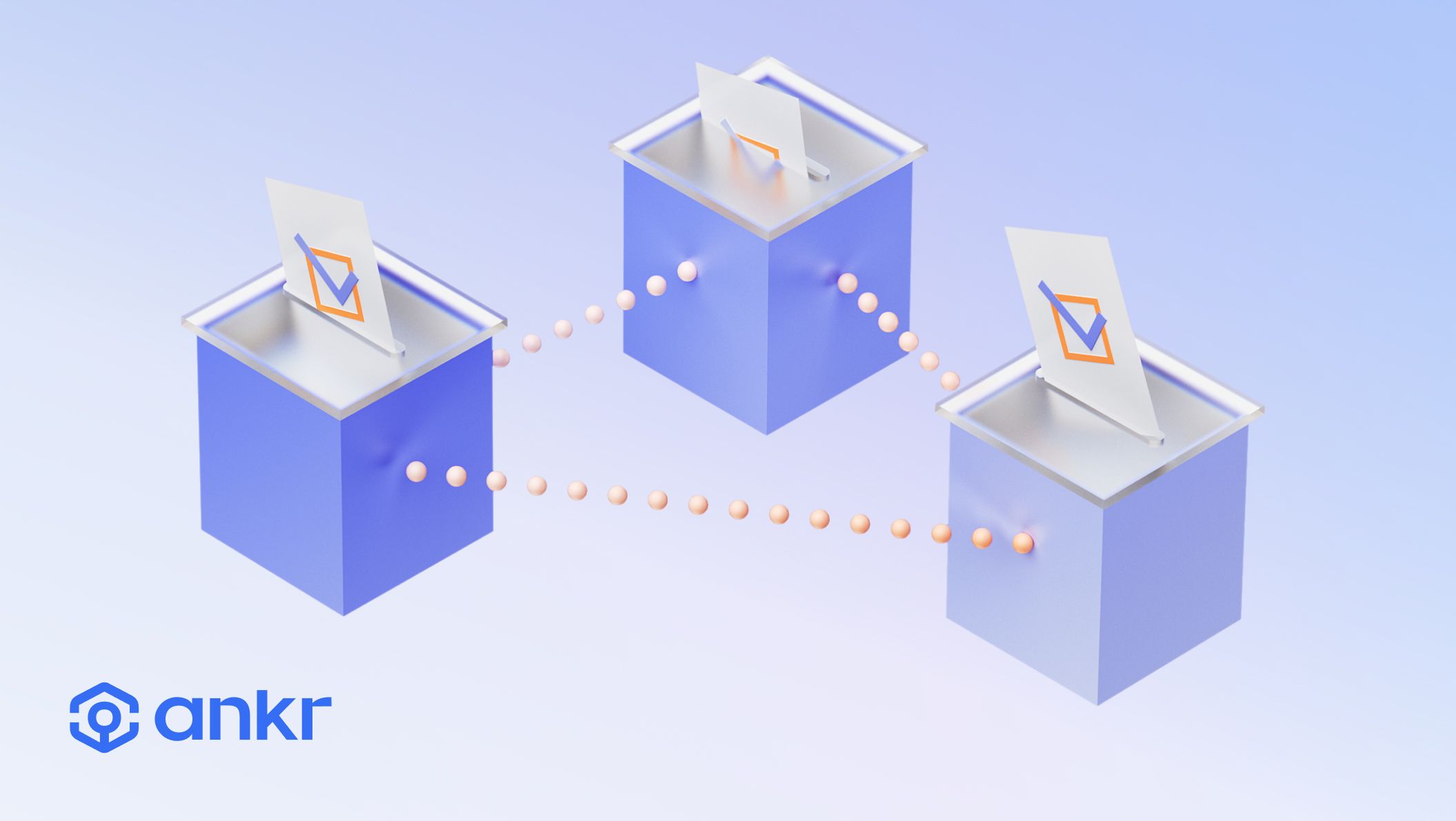How Blockchains Increase Trust In Voting & Elections

Kev Silk
November 7, 2022
9 min read

Web3 technology is the solution to the current inefficiencies in outdated voting systems.
Watching the World Series last night, I couldn’t help but notice the number of political advertisements on display. Of course, we expect this as we enter the home stretch of midterm elections in the United States, where Democrats and Republicans flood the airwaves. Both sides feel the need to portray opponents in a negative light to capture the hearts of the American people. During these commercials, I wondered why people often think voting is a chore and, more importantly, why the results inevitably lead to a less-than-ideal outcome for everyone.
Many Americans feel a sense of disenfranchisement and jadedness when the election season begins. Elections should empower people to create change that will better serve our country. There are various reasons for these sentiments — one of which is the technology associated with the voting process. While much of the world has become digitalized through technological advancements, the voting system has failed to adapt. The failure to create foundational change in the system can lead to mistrust in the processes and outcomes. For a country to be a democracy, we must be able to trust the democratic process of electing public officials. We must update our democratic process with new technologies focusing on trust and transparency.
Problems with the American Voting System
I’m a web3 product manager and designer, so naturally, my mind compares the user experiences of voting to that of a decentralized application running on a blockchain. I look at the areas of improvement and view the “users” as the citizens submitting their ballots. The experience is the countrywide task of voting, which is the heart of being an American. Here are a few significant “areas of improvement” with voting that can upgrade by utilizing blockchain technology.
Fair warning: Blockchain technology cannot solve the first issue entirely, but with our country’s current division, it deserves mention.
Unproductive Rhetoric & Confusing Measures
Political advertisements focused on defaming their competition rather than portraying a positive problem-solving attitude are pointless. Whether it’s the president or the local town mayor, this campaign strategy of elected officials is unproductive and unhealthy for the country. The smear campaign strategy is also unfair to citizens, as it pins American individuals against each other.
When tensions rise, people’s patience declines, resulting in aggressive arguments between the far left and far right. To remove this societal unrest, we (and elected officials) should genuinely listen to one another’s views and reason and find common ground. How do we find common ground? Let’s start by trying to hear both sides of a debate and understand the issues; this will help provide a clear view of the proposed changes both parties make.
With that said, this is only my opinion. My thoughts on political strategies are to be taken with a grain of salt as I don’t plan on working on a campaign or ever running for elected office. Instead, my passion lies with blockchain technology, and my work focuses on building web3 infrastructure that moves power over the internet from centralized authorities to distributed networks of individuals. However, blockchains can solve many other essential issues that I will describe in detail.
Inefficient Voting Experiences
Technological advancements are moving at light speed, but the voting system is not progressing as swiftly. This lack of innovation leads to several bottlenecks and inefficiencies in the mail-in ballot system and in-person voting. Especially in presidential elections, the process takes far too long, and it’s met with demands for recounts and accusations of voter fraud.
Voting on the blockchain can help solve this problem. On-chain voting is a digital process of casting and storing votes on a blockchain. This solution provides a secure yet transparent database verified and agreed upon by several or perhaps thousands of computers working in unison to record data exactly how it arrives. Once the computers store the votes on-chain, the results are immutable and verifiable.
Voting on-chain would help the election process become more accurate, fast, and transparent. We can see if your vote was counted and confirmed with a block explorer — a place to view all of a blockchain’s transactions. With added tools and digital verification processes, people could vote from anywhere — improving the likelihood of participation. Furthermore, the secure voting experience powered by cryptography protects the chances of election fraud.
Complicated Government Processes
The American government, as we all know, is slow to change and riddled with bureaucracy, stalemates, and websites that have low-performance qualities. These often-dated standards extend to the voting system with overcomplicated processes in the electoral college, excessive representatives, and processes that most Americans don’t have the time to study. New technologies provide opportunities to streamline the system and reconsider procedures. The chance to utilize blockchains in 2022 can improve government processes and reshape the voting system, turning it into something everyone can understand.
Outdated Technology
Elections occur with outdated methods of collecting paper mail and in-person voting booths. Both ways are rife with inefficiencies, complexities, human error, and foul play. There’s no need for people to vote in person and have trust brought in by humans to store results when we can vote digitally and have trust built in through cryptographic code on-chain. Not everyone has access to a smartphone, so digital voting booths or even accessing a digital account via a public library computer is feasible to start.
Storing votes on-chain comes with potential drawbacks, such as hacking or digital outages. However, we can eliminate attack vectors with the proper architecture that a permissioned blockchain provides. Permissioned blockchains differ from public blockchains like Ethereum because they have prerequisites or “permissions” that must be satisfied before someone can enter the chain. Registering and storing votes on a government-backed permissioned chain would require citizens to prove their identity. To validate an identity, one would enter their social security or passport before they are verified to vote on the blockchain. However, even though the blockchain requires permission to access, it can display data transparently to all verified users, which is vital for the efficacy of a voting platform.
We can implement safeguards to ensure information is never leaked or unencrypted in the wrong hands. With thousands of nodes run by independent parties to validate and store voting results, we eliminate the risk of outages and ensure that no one entity can interfere with the process. Although the government would operate the chain, access to the legitimate results of the election is not only for those in elected office. The citizens who validate their identity and enter the chain can also view how the election plays out. Every vote is confidently collected and stored on a tamper-proof system so all members can view the results in real time.
Solutions From Blockchain Technology
How could storing votes on a blockchain increase registered voters and help citizens gain trust in the government and voting system?
Blockchains are trustless, which means that when we make transactions (like submitting a vote), the trust to verify that transaction is not brought in by additional humans because it is already built-in with cryptography. The current voting system requires you to submit your vote at the ballot and trust the person at the box. You also depend on the town and state you live in to tally votes correctly and trust the American government. There’s trust required to vote, and it can be challenging to trust a process that is not entirely transparent. The voting system is inconvenient, requiring people to visit boxes in person, which means taking time off from work and standing in line. Technological changes can help increase convenience and accessibility, thus increasing the likelihood of participation.
Increased Transparency
Storing votes On-chain means we can track who registered to vote and where they are allowed to vote. The open ledger provides trust for the public, knowing everybody entitled to vote can do so. By recording results permanently on the blockchain, votes will no longer have the risk of being “thrown out”. Anyone can validate their vote on the block explorer to alleviate any fraud concern. Voter identification is no longer a concern either, as we store ID’s through immutable data that is processed once.
More Accessibility
Moving to the blockchain would remove the need to take time off work or any other daily life responsibility to vote. In their simplest form, blockchains are software, so people can download the election application, verify their identity (to enter the chain), and cast their vote. This increase in convenience will result in more people voting, and more voices heard around the country, so we can ensure that the government is working for every citizen.
Faster Processing Times
Rather than people communicating manually to deliver the voting results, we can display the election’s results instantly on-chain. This process works by encoding elections into smart contracts, which allow us to count votes and make changes that citizens want to see faster and more efficiently.
Enhanced Security
Voting on chain introduces a seemingly unhackable system, as we would verify the results in real-time. There are several advantages to voting online and storing every citizen’s vote on a blockchain. Nonetheless, a permissioned and private blockchain is necessary, with only U.S. citizens and government officials accessing it. Citizens and government officials can view the data without tampering with it, as the chain will run autonomously. However, any engineering or infrastructure changes to the blockchain will need to be voted on, approved, monitored, and audited by many independent parties.
Using a permissioned blockchain alleviates the risk of miscounts because we record all data on a s recorded on a publicly accessible ledger. All voters can verify and bear witness to the validity of election results. Additionally, all secure nodes power the system, which allows us to treat all voters equally, which is imperative when considering vote tampering.
Decreased Operational Costs
Creating an entirely trustless and digital voting system means we no longer need to pay for printing materials, expensive equipment, and high transportation workforce costs. Furthermore, we decrease the burden on a volunteer election workforce. Instead of needing to count votes, they can focus on educating voters on the issues and ensuring everyone has access to the new digital voting system.
Final Thoughts
It’s exciting to imagine a blockchain application extending beyond the DeFii space to other industries and sectors. Blockchain technology improves society by enhancing and updating old systems for the twenty-first century. Blockchain solutions such as Central Bank Digital Currencies (CBDCs) will eventually become a new international standard for money. Therefore, it is only a matter of time before blockchain extends into other critical government processes like voting. Voting innovation is critical now — and technological improvements can help us create a more efficient, transparent process. It’s up to us in Web3 to propose new solutions that improve life for everyone and ensure our democracies stay intact. Regarding voting, I’m confident we will do so and eager to see what we can build.



